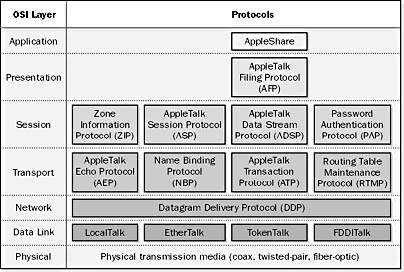AppleTalk
AppleTalk is a set of network protocols and was developed by Apple Computer in late 1983 to allow easy access to common resources such as files or printers on the network. AppleTalk is a registered trademark of Apple, Inc.
Through the initial exclusive linking AppleTalk with the later renamed to LocalTalk network hardware, is often mistakenly used as a synonym for AppleTalk LocalTalk cabling.
The decision to own network protocols, as well as to establish LocalTalk as a proprietary transmission medium, resulted from the 1983 prevailing circumstances: Network hardware was rarely standardized and very expensive; the cost often reached the cost of a personal computer itself
Given the widespread use of IP -based networks AppleTalk was abandoned from Mac OS X 10.6 from Apple. All essential services are either mapped to TCP / IP (for example, file access via AFP, TCP port 548 ) or by other existing protocols replaced (example: printer access via LPR or JetDirect ports or IPP, finding of devices and services on the network using Bonjour ). Bonjour is, however, limited in its capabilities on a network segment, as there is no possibility to organize network devices over logical zones.
There were for non-Apple PCs and ISA, MCA and SBus cards with LocalTalk interface, so that such computers will be integrated in an AppleTalk network, and shared data and printers could be shared.
History
AppleTalk is largely based on the ( non-patented ) Cambridge ring.
Overview
AppleTalk dominated two addressing modes: Extended ( Phase 2) and Nonextended (Phase 1).
AppleTalk addresses devices using a dynamically-assigned address. This address consists of a 16-bit network address together (only phase 2) and an 8 -bit node ID. The network address can be defined within a continuous range of a router. The network address is 0 stands for the local network segment, the network addresses 65280-65534 are reserved. The node ID 0 is invalid, 1-127 is intended for users, 128-254 server, 255 for broadcast. This is followed by an 8-bit socket number closes to distinguish the services on that device. The sockets 0 and 255 are invalid, 1-127 are for static and 128-254 are for dynamic assignment of thought.
A typical AppleTalk address would 1248.33:4.
AppleTalk is familiar with the concept of zones. These enable a logical grouping of devices that do not must match the physical structure of network segments. Phase 2 networks supporting more than one zone per segment. The user can then select the zone membership. This zone list appears in the user program selection.
Thus, users do not have to deal with little catchy numerical addresses, a dynamic name service (NBP ) is provided. Server services to register with the respective local NBP service. Network side based on these multicasts. The selection sends multicasts and carries the individual responses to a list view together.
The AppleTalk protocols
The AppleTalk family includes the following protocols (grouped by network layers ):
Application and presentation layer
- Apple Filing Protocol (AFP) - access to shared files
- Apple Printer Access Protocol (PAP ) - Data exchange with print services and PAP -enabled printers
- AppleTalk Update -based Routing Protocol ( AURP ) - AppleTalk tunneling via TCP / IP and point-to -point connections over UDP port 387 (RFC 1504)
Session layer
- Zone Information Protocol (ZIP) - provides information about your network zone and other zones
- AppleTalk Session Protocol (ASP ) - protocol for controlling sessions
- AppleTalk Data Stream Protocol ( ADSP ) - connection-oriented protocol for the exchange of data streams
Transport layer
- AppleTalk Transaction Protocol (ATP) - transaction protocol that guarantees reliable, sequence- abiding parcel delivery
- AppleTalk Echo Protocol ( AEP) - is used to determine the round-trip time, and determine the accessibility of a network user.
- Name Binding Protocol ( NBP) - assignment of names to addresses
- Routing Table Maintenance Protocol ( RTMP) - management of routing tables
Network layer
- Datagram Delivery Protocol ( DDP) - connectionless, non- reliable datagram delivery service
Backup and physical layer
It supports multiple link access protocols ( Link Access Protocols, LAP), which are managed by the so-called LAP Manager.
- LocalTalk LAP ( LLAP )
- Ethernet LAP ( ELAP ) (referred to by Apple as EtherTalk )
- Token Ring LAP ( TLAP )
- FDDI ( Fiber Distributed Data Interface)
- PPP AppleTalk Control Protocol ( ATCP ) (RFC 1378 )
- AppleTalk Address Resolution Protocol ( AARP ) - address mapping between network addresses that are used by the DDP, and device addresses of the link layer.
The physical layer includes the drivers for the network interface.
The AppleTalk protocol stack
The AppleTalk protocols can be divided into several layers that form a protocol stack ( protocol stack ). The protocols can be classified as follows in the ISO - OSI reference model:
Relation to other protocols
AppleTalk is routable, all participating routers have to support AppleTalk, but is considered a " talkative ", that produces continuous packet transmissions, with some AppleTalk - capable routers (eg Cisco or Motorola's Farallon ) were able, these mainly from keepalive packets to emulate existing traffic ( AppleTalk spoofing ), so that a permanent connection could be circumvented. Connections over X.25 networks were also possible. The connection of two remote AppleTalk networks eg via the TCP / IP-based Internet is therefore not directly, but only through encapsulation (eg Kinetics Internet Protocol ) is possible, see product description from the Apple Internet Router.
Trivia
Due to the small packet size of the underlying Datagram Delivery Protocol ( 13 byte header, 587 bytes of user data ) AppleTalk scaled poorly to faster transmission distances than 10 Mbit / s Ethernet, the data throughput on Fast Ethernet is in fast involved network components about one-third of the possible.










